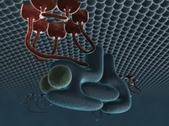
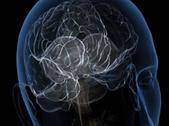
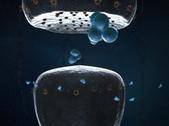
Professor Anthony Dickenson, BSc, PhD, FmedSci |
| Professor of Neuropharmacology |
| Tel: +44 (0)20 7679 3742 |
| Email: anthony.dickenson@ucl.ac.uk |
|
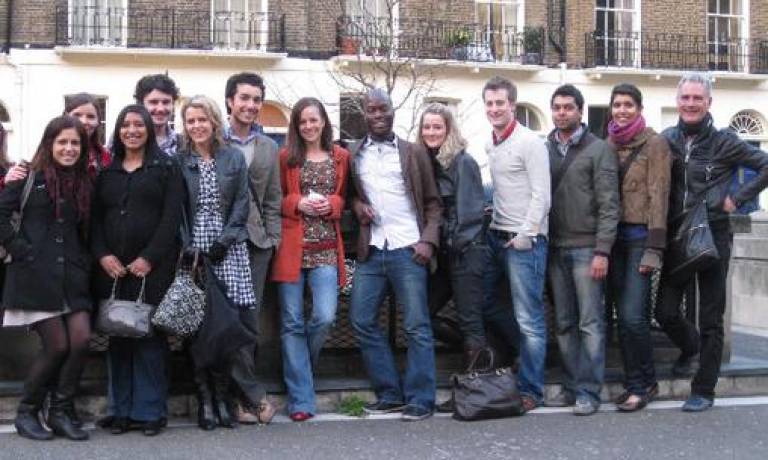
Anthony Dickenson, BSc, PhD, FmedSci is Professor of
Neuropharmacology at University College, London. He gained his PhD at
the National Institute for Medical Research, London, has held
Fellowships and posts in Paris, California and Sweden, and was appointed
to the Department of Pharmacology at University College in 1983. He
has made seminal contributions to understanding the mechanisms of pain
and how pain can be controlled in both normal and patho-physiological
conditions and how to translate basic science to the patient. He has
supervised 18 completed PhD students and makes a major contribution to
undergraduate science and medical teaching.
He is a founding and continuing member of the London Pain Consortium, a
Wellcome Trust Integrated Physiology Initiative and now a Strategic
Award, funding a group of scientists in London and Oxford studying pain
mechanisms and training young scientists in integrated approaches to the
study of pain from genes to function. He is training director of the
programme.
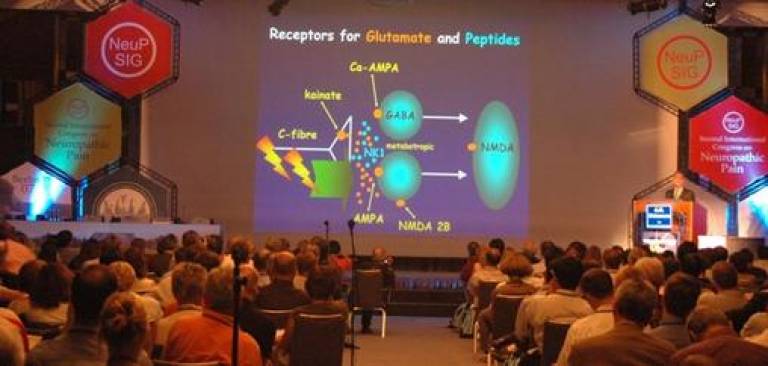
House of Pain old and new: (Left to right) Leonor Goncalves, Victoria Harvey, Sital Patel, Liam Burnham, Lucy Bee, Matt Thakur, Kirsty Bannister, Curtis Asante, Amy Fisher, Richard Gordon-Williams, Richard D'Mello, Shafaq Sikandar, Tony Dickenson
Prof. Dickenson was a member of the Council of the International Association for the Study of Pain for 6 years and is an associate editor for the journal Pain. He is a regular assessor of grant applications for the MRC, BBSRC, Wellcome Trust, Human Frontiers Programme and is a member of the research committee of INSERM, France.
He has been a member of the Medical Research Council Postgraduate Assessment Committee, the Brain Research Association National Committee, The International Association for the Study of Pain, Scientific Commission and the UK Pain Society Executive Committee as well as the Scientific commission of the European Federation of Pain Societies.
He has a grant income from research councils and charities of £1.3 million over the last 5 years and has authored more than 250 refereed publications including Science and Nature, edited 3 books and written numerous chapters. He has made many media appearances including BBC1, 2 and Channel 4 and spoken at the Royal Institution.
Prof. Dickenson has given plenary lectures at the World Congress on Pain, the European Pain Congress, the US National Pain Forum and numerous Pain Societies including the ASEAN, American, Canadian, Belgium, Scandinavian, British, Thailand, Irish and the Australian Pain Societies and at many other international and national meetings. He also speaks to GPs, at hospices and to schools. He was elected into the Academy of Medical Sciences in 2007 and was made an Honorary Member of the British Pain Society in 2009 for ' an outstanding contribution to the alleviation of pain through personal endeavor and through his work for the Society'.

Our research has been based on understanding the transmission and control of pain related to improving its treatment, either through better knowledge of mechanisms or characterization of novel targets. The approach has been to understand how pain changes the nervous system.The groupI have studied how neuronal systems alter in patho-physiological states and how novel and licensed drugs produce their effects on pain processes. We have made many major advances in this area and the aim has been to translate the basic research into clinical applications.
Early on we described Diffuse Noxious Inhibitory controls (DNIC) and subsequently provided a detailed description of their neural basis. DNIC are used as a possible diagnostic in chronic pain patients. At UCL, our original pioneering work on the neuronal actions of opioid receptors lead to major advances in opioid function, the idea of pre-emptive analgesia and other important clinical translations. We were the first group to show the NMDA receptor mediation of wind-up, then its role in persistent pain. This and our continuing work on central hyperexcitability has been seminal in understanding of pain in animals and humans. We further initiated some of the very first studies on the pharmacology of the developing spinal cord related to paediatric pain control. We have studied a number of novel mediators ranging from nitric oxide, adenosine, nicotinic ligands and newer opioids. Assessment of drug combinations has also guided clinical practice.
More recently, we have taken our work on the plasticity of spinal signalling after inflammation to other pain states to examine changes after nerve injury and adapted and further developed a rodent model of bone cancer, all of which have informed clinical practice. At the same time we have some very fruitful collaborations with molecular groups. We have provided evidence for roles of targets that include sodium channels found in peripheral neurons and central G-protein linked receptors within integrated systems using levels and ranges of stimuli that cannot be assessed by behavioural approaches. Further advances using pharmacological tools are exemplified by functional identification of roles for Kv7/M and other potassium channels that could be novel pain targets. Ongoing active studies include assessing tissue specific knock-outs with Prof J Wood, and our original extensive work on calcium channel function in pain has lead to international collaborations on the roles of splice variants and over-expressing of calcium channel subunits. Finally, in the last 2 years, our original studies with novel techniques on spinal neurones that project to the brain and engage descending brainstem serotonergic influences to the cord to enhance spinal excitability have had major implications for the understanding how pain shapes emotional changes. We have shown the integrity of this pathway is a crucial determinant of both the abnormal neuronal and behavioural manifestation of nerve injury. This pathway also has a major bearing on efficacy of drugs used in neuropathic pain and has been verified in humans through imaging and clinical trials of novel analgesics.
Dr Wahida Rahman (Wellcome Trust) is investigating the role of excitatory spino-bulbo-spinal loops in nociceptive transmission in different pain states. This pathway originates in the spinal cord and culminates in the activation of a descending facilitatory drive from the brainstem back onto spinal neurones, She studies the relative contribution of this excitatory pathway in chronic pain and is looking at the potential contribution of other transmitter systems in the effects of pregabalin.
Dr Amy Fisher (BBSRC) is investigating how gabapentin only exerts its analgesic activity in pathological conditions, where there is a state of neuronal hyper-excitability. Investigations are exploring whether other excitatory receptors/neurotransmitters e.g. pre-synaptic glutamate receptors may also have a permissive effect on the actions of gabapentin.
Dr Lucy Bee (BBSRC) is concerned with investigating the sensory role of the brainstem RVM zone in normal and pathophysiological states, and in particular the part played by facilitatory neurones. This is achieved by pharmacologically manipulating neurones in the RVM and looking at the evoked responses of dorsal horn neurones in the spinal cord to a range of stimuli after nerve-injury. More recently, she is investigating the roles of ion channels in different pain pain states.
Dr Kirsty Bannister (NIH) is currently investigating how central events can contribute to diffuse pain states in a project aimed at understanding generalized pains such as in fibromyalgia. She uses molecular biological and electrophysiological approaches to understand spinal mechanisms of hyperexcitability where the periphery is normal.
Dr Leonor Goncalves (LPC Wellcome Trust) is studying how neuronal events in the amygdala, a part of the brain implicated in the affective responses to pain are altered in states of nerve injury. The electrophysiological studies will test the effects of clinically used drugs on this activity in order to understand how and where treatments produce their effects.
Richard D'Mello (LPC Wellcome Trust) is interested in the role of the direct interaction between the glutamatergic NMDA receptor and the cytoskeletal protein PSD-95 in spinal sensory processing and mechanisms of synaptic plasticity which may contribute to spinal central sensitization, as well as elucidation of the downstream intracellular signalling pathways.
Shafaq Sikandar (BBSRC-CASE) is currently investigating the role of descending serotonergic controls in visceral pain. Accordingly, her research involves the use of compounds that alter 5HT receptor function in order to evaluate how these compounds alter visceral pain sensation in normal conditions, as well as in inflammatory pain states.
Sital Patel (BBSRC) is studying the contribution of central spinal sensitization to the altered neuronal processing that can occur in different pain states. She is studying the mechanisms that underlie the pain of osteoarthritis and cancer-induced bone pain and the potential for novel treatments for this inflammatory pain condition.
Matthew Thakur (LPC Wellcome Trust) is studying the roles of certain channels in osteoarthritis and neuropathy. These investigations using both behaviour and electrophysiology aim to assess the involvement of HCN channels and the m-current in these chronic pain states as well as their potential novel central pain mechanisms.
Liam Burnham (MRC) is studying the neuronal coding mechanisms that occur in the parabrachial area of the midbrain that contribute to the altered neuronal processing that can occur in different pain states. This area is a key relay in ascending pathways from spinal cord to the limbic brain.
Collaborations: With Prof John Wood (UCL), Profs Annette Dolphin and Neil Millar (UCL), Dr Lars Rygh (Bergen) and Prof Frank Porreca (U of Tucson) plus within the London Pain Consortium.
 Close
Close

